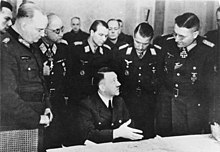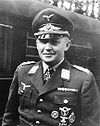Army Group Vistula
| Army Group Vistula | |
|---|---|
| German:Heeresgruppe Weichsel | |
| Active | 24 January – 8 May 1945 |
| Country | |
| Branch | |
| Type | Army |
| Size | 104,162 combat troops (1 April 1945)[1] |
| Engagements | Eastern Front |
| Commanders | |
| Notable commanders | Heinrich Himmler Gotthard Heinrici |
Army Group Vistula(German:Heeresgruppe Weichsel) was an Army Group of theWehrmacht,formed on 24 January 1945. It lasted for 105 days, having been put together from elements ofArmy Group A(shattered in the SovietVistula-Oder Offensive),Army Group Centre(similarly largely destroyed in theEast Prussian Offensive), and a variety of new orad hocformations. It was formed to protectBerlinfrom theSovietarmies advancing from theVistula River.
Establishment and history
[edit]
Heinz Guderianhad originally urged the creation of a new army group as an essentially defensive measure to fill the gap opening in German defences between the lowerVistulaand the lowerOder.[2]
The new Army Group Vistula was duly formed from an assortment of rebuilt, new and existing units. Guderian intended to propose Field-MarshalMaximilian von Weichsas commander.[3]However, in a reflection ofHitler's desire to transfer control of the conflict from theWehrmachtto theSS,Heinrich Himmlerwas appointed.[4]Himmler, who lacked any real military knowledge,[note 1]proved inadequate to the task; GeneralGotthard Heinricireplaced Himmler as commander of Army Group Vistula on 20 March, subsequent to its participation in the German offensive codenamedOperation Solsticeand the following defence against the SovietEast Pomeranian Offensive.
Between January and February 1945, Army Group Vistula sustained 98,000 casualties, including 15,000 dead, 50,000 wounded (not counting non-evacuees), and 33,000 missing.[1]: 559 On 1 April 1945, it had 185,975 assigned personnel (split between the 9th Army and the 3rd Panzer Army), with 104,162 soldiers in active combat, 21,946 sick and wounded since 1 February, and 318 vacationers.[1]: 607
The Army Group's only offensive action was Operation Solstice, the failed attempt to relieve the fortress ofKustrinlate in March 1945, during which the subordinateXXXIX Panzer Corpstook heavy casualties.

Under the command of Gotthard Heinrici, parts of the army group fought through theBattle of BerlinandBattle of Halbe,with some of its elements not surrendering until theend of the war in Europeon 8 May 1945. Army Group Vistula's strength was in the region of 500,000 troops;[3][note 2]in general, the army group was poorly equipped, many of its units being little more than the 'paper' formations typical of the German military at the end of World War II. Indeed, when first set up it was found that the army group lacked many essential facilities, such as proper maps or a headquarters signals detachment—the sole means of communication being Himmler's private telephone.[5]
Organisation
[edit]The Army Group was originally formed from:
- The9th ArmyofGeneral der InfanterieTheodor Busse,which had previously been part ofArmy Group Aand had been shattered aroundWarsawduring theVistula-Oder Offensive.This now held lines on theOderand was progressively rebuilt.
- The2nd ArmyofGeneraloberstWalter Weiß,which as part ofArmy Group Centrehad been defending the line of theNarewriver on the borders ofEast Prussia.TheEast Prussian Offensivehad cut it off from the remnants of its parent formation, and by late January it defended a long sector fromElbingin the east running westwards throughPomerania.It therefore formed the new army group's northern and eastern flank.
- The11th SS Panzer Armywas a 'new' formation which had been assembled in western Pomerania. Soon after its formation it received the commanderObergruppenführerFelix Steinerand other staff of the3rd Panzer Army,which had been largely destroyed in East Prussia.
During theEast Pomeranian Offensive,the Second Army was finally cut off from the remainder of the army group and withdrew intoDanzig,where it was eventually destroyed. The rest of Army Group Vistula was forced west of theOder,though the Third Panzer Army retained a small bridgehead atAltdammuntil the middle of March.
Towards the end of April, theTwenty-First Army(itself formed around the remnants of theFourth Army,which had been destroyed in theHeiligenbeil Cauldron), commanded byGeneral der InfanterieKurt von Tippelskirch,was added to Army Group Vistula.
Order of Battle during Soviet Berlin Offensive
[edit]- German 3rd Panzer Army(General der PanzertruppeHasso von Manteuffelfrom 9 March 1945 to 8 May 1945)
- III (Germanic) SS Panzer Corps(ObergruppenführerFelix Steiner) (later transferred to Twenty-First Army, below)
- CI Corps(later transferred to Twenty-First Army, see below)
- XXVII Corps(later transferred to Twenty-First Army, see below)
- XXXII Corps
- XXXXVI Panzer Corps
- VerteidigungsbereichSwinemünde
- German 21st Army(General der InfanterieKurt von Tippelskirch)
- German 9th Army(General der InfanterieTheodor Bussefrom 20 January 1945 to 2 May 1945)
- CI Corps(to mid-April)
- LVI Panzer Corps(General der ArtillerieHelmuth Weidlingfrom 12 April 1945 to 23 April 1945)
- XI SS Panzer Corps
- V SS Mountain Corps
Commanders
[edit]| No. | Portrait | Commander | Took office | Left office | Time in office |
|---|---|---|---|---|---|
| 1 | Reichsführer-SS Heinrich Himmler (1900–1945) | 24 January 1945 | 20 March 1945 | 55 days | |
| 2 | Generaloberst Gotthard Heinrici (1886–1971) | 20 March 1945 | 28 April 1945 | 39 days | |
| - | General der Infanterie Kurt von Tippelskirch (1891–1957) Acting | 28 April 1945 | 29 April 1945 | 1 day | |
| 3 | Generaloberst Kurt Student (1890–1978) | 29 April 1945 | 8 May 1945 | 9 days |
See also
[edit]Notes
[edit]- ^Although this was not Himmler's first such operational military high command appointment. Between 10 December 1944 and 24 January 1945 (the day before he took up this command) he commandedArmy Group Oberrhein.
- ^who states that German sources give the group's size as 32-34 divisions, while a "good Soviet source" identifies it as having 450,000 troops.Duffy 1991,p. 177
Footnotes
[edit]- ^abcLakowski, Richard (2008). "Der Zusammenbruch der deutschen Verteidigung zwischen Ostsee und Karpaten". In Müller, Rolf-Dieter (ed.).Die Militärische Niederwerfung der Wehrmacht.Das Deutsche Reich und der Zweite Weltkrieg (in German). Vol. 10/1. München: Deutsche Verlags-Anstalt. pp. 491–681.ISBN9783421062376.
- ^Duffy 1991,p. 176.
- ^abDuffy 1991,p. 177.
- ^Beevor 2002,p. 52.
- ^Beevor 2002,p. 54.
References
[edit]- Beevor, A.(2002).Berlin: The Downfall 1945.Penguin Books.ISBN0-670-88695-5.
- Duffy, C.(1991).Red Storm on the Reich: The Soviet March on Germany, 1945.Routledge.ISBN0-415-22829-8.
- Hastings, M.Armageddon. The Battle for Germany 1944–45.London: Macmillan.




